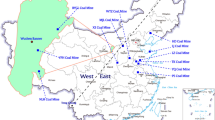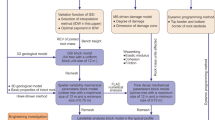Abstract
Mine development leads to inevitable environmental consequences resulting in so called ‘mine hazard’, which occur extensively over a long period of time across a large area. The mine subsidence is considered as one of the most serious mine hazards, while the proper method is required to evaluate the mine subsidence risk. In this study, a new assessment technique to evaluate the subsidence risk in mining areas was developed using numerical and statistical analysis. Numerical simulations using FLAC2D and strength reduction method were performed to evaluate the effect of geometrical features of cavities and rock mass conditions on the ground subsidence. Based on the numerical results, the relationship between the influencing factors and the factor of safety was quantitatively obtained. It was found that the rock mass condition, height and thickness of a mined cavity has a negative effect on the subsidence while the depth and inclination of the cavity has a positive effect. The prediction model for subsidence hazard level (SHL) was proposed from the statistical regression analysis. The proposed assessment technique considered two additional important factors which were the influence area of subsidence at surface and the interaction of multiple cavities. Finally, the developed assessment technique was applied to an actual mine site to validate its accuracy. The result showed that predicted subsidence hazard map had a good agreement with the subsidence traces observed in the mine site.
Similar content being viewed by others
References
Aksin H (2021) A GIS-based building risk assessment for the subsidence due to undercity coal mining activities in Zonguldak, Turkey. Arabian Journal of Geosciences 14:376, DOI: https://doi.org/10.1007/s12517-021-06702-6
Alejano LR, Ramírez-Oyanguren P, Taboada J (1999) FDM predictive methodology for subsidence due to flat and inclined coal seam mining. Int J Rock Mech Min Sci. 36(4):475–491, DOI: https://doi.org/10.1016/S0148-9062(99)00022-4
Asadi A, Shakhriar K, Goshtasbi K (2004) Profiling function for surface subsidence prediction in mining inclined coal seams. Journal of Mining Science 40(2):142–146, DOI: https://doi.org/10.1023/B:JOMI.0000047856.91826.76
Bahuguna PP, Srivastava AMC, Saxena NC (1991) A critical review of mine subsidence prediction methods. Mining Science and Technology 13(3):369–382, DOI: https://doi.org/10.1016/0167-9031(91)90716-P
Bekendam RF (2004) Stability and subsidence assessment over shallow abandoned room and pillar limestone mines. In: Hack R, Azzam R, Charlier R (eds) Engineering Geology for Infrastructure Planning in Europe. Lecture Notes in Earth Sciences, Springer, Berlin, 657–670, DOI: https://doi.org/10.1007/978-3-540-39918-6_73
Brady BHG, Brown ET (2007) Rock mechanics for underground mining, Springer, Berlin
Cai F, Ugai K (2000) Numerical analysis of the stability of a slope reinforced with piles. Soils and Foundations 40(1):73–84, DOI: https://doi.org/10.3208/sandf.40.73
Caudron M, Emeriault F, Kastner R, Al Heib M (2006) Numerical modelling of the soil structure interaction during sinkholes. Proceedings of the 6th European Conference on Numerical Methods in Geotechnical Engineering — Numerical Methods in Geotechnical Engineering, Graz, Austria, 267–273
Chai J, Suddeepong A, Liu MD, Yuan DJ (2017) Effect of daily fluctuation of groundwater level on land-subsidence. International Journal of Geosynthetics and Ground Engineering 3(1), DOI: https://doi.org/10.1007/s40891-016-0079-x
Chakraborti S, Konietzky H, Walter K (2012) A comparative study of different approaches for factor of safety calculations by shear strength reduction technique for non-linear hoek-brown failure criterion. Geotech Geol Eng. 30:925–934, DOI: https://doi.org/10.1007/s10706-012-9517-2
Chen B, Gong H, Li X, Lei K, Zhu L, Gao M, Zhou C (2017) Characterization and causes of land subsidence in Beijing, China. International Journal of Remote Sensing 38(3):808–826, DOI: https://doi.org/10.1080/01431161.2016.1259674
Cheng YM, Lansivaara T, Wei WB (2007) Two-dimensional slope stability analysis by limit equilibrium and strength reduction methods. Comput Geotech. 34(3):137–150, DOI: https://doi.org/10.1016/j.compgeo.2006.10.011
Choi SO, Kim KS (2003) Ground stability analysis on the limestone region. Geosystem Eng. 6(2):33–39, DOI: https://doi.org/10.1080/12269328.2003.10541202
Dawson EM, Roth WH, Drescher A (1999) Slope stability analysis by strength reduction. Geotechnique 49(6):835–840, DOI: https://doi.org/10.1680/geot.1999.49.6.835
Dawson EM, You K, Park Y (2000) Strength-reduction stability analysis of rock slopes using the Hoek-Brown failure criterion. Proceedings of the Geo-Denver 2000, Denver, USA, 65–77
Díez RR, Álvarez JT (2000) Hypothesis of the multiple subsidence trough related to very steep and vertical coal seams and its prediction through profile functions. Geotech Geol Eng. 18:289–311, DOI: https://doi.org/10.1023/A:1016650120053
Fu W, Liao Y (2010) Non-linear shear strength reduction technique in slope stability calculation. Comput Geotech. 37(3):288–298, DOI: https://doi.org/10.1016/j.compgeo.2009.11.002
Griffiths DV, Lane PA (1999) Slope stability analysis by finite elements. Geotechnique 49(3):387–403, DOI: https://doi.org/10.1680/geot.1999.49.3.387
Hammah RE, Yacoub TE, Corkum BC, Curran JH (2005) The shear strength reduction method for the generalized Hoek-Brown criterion. Proceedings of the 40th US Symposium on Rock Mechanics (USRMS), Alaska, USA
Harrison P (2011) Mine subsidence. In: Darling P (ed) SME mining engineering handbook, 3rd edition SME, USA, 627–644
Hoek E, Carranza-Torres C, Corkum B (2002) Hoek-brown failure criterion — 2002 Edition. Proceedings of the 5th North American rock mechanics symposium and the 17th tunnelling association of Canada (NARMS-TAC) conference, Toronto
Huang F, Zhang DB, Sun ZB, Jin QY (2012) Upper bound solutions of stability factor of shallow tunnels in saturated soil based on strength reduction technique. Journal of Central South University 19:2008–2015, DOI: https://doi.org/10.1007/s11771-012-1238-4
Jeon B, Jeon S, Kim J, Kim TH (2012) Numerical evaluation of affecting parameters of surface subsidence in abandoned mine areas. Geosystem Eng. 15(4):299–304, DOI: https://doi.org/10.1080/12269328.2012.706386
Jung YB, Kim TH, Song WK, Choi GS, Kwon HH (2010) Development of mine subsidence hazard estimation method through the analysis of influential factors on subsidence. Journal of Korean Society of Geosystem Engineering 47(3):324–338
Jung YB, Song WK, Cheon DS (2014) Simple method for the identification of subsidence susceptibility above underground coal mines in Korea. Eng Geol. 178(21):121–131, DOI: https://doi.org/10.1016/j.enggeo.2014.06.006
Keilich W, Seedsman RW, Aziz N (2006) Numerical modelling of mining induced subsidence. Proceedings of the Coal Operator’s Conference, Brisbane, Australia, 313–326
Kim JW, Song WK, Chang KT (2007) Effect of a mine roadway on the ground subsidence using scaled model tests, Journal of Korean Society of Geosystem Engineering 44(3):208–217
Kim KD, Lee S, Oh HJ, Choi JK, Won JS (2006) Assessment of ground subsidence hazard near an abandoned underground coal mine using GIS. Environmental Geology 50:1183–1191, DOI: https://doi.org/10.1007/s00254-006-0290-5
Labuz JF, Zhang A (2012) Mohr-Coulomb failure criterion. Rock Mech Rock Eng. 45:975–979, DOI: https://doi.org/10.1007/s00603-012-0281-7
Lee SJ, Choi SO (2011) A study on theoretical consideration and numerical analysis according to dip angle of joint for volumetric expansion ratio of rock mass. Geosystem Engineering 14(1):1–8, DOI: https://doi.org/10.1080/12269328.2011.10541323
Lin S, Whittaker BN, Reddish DJ (1992) Application of asymmetrical influence functions for subsidence prediction of gently inclined seam extractions. International Journal of Rock Mechanics and Mining Sciences & Geomechanics Abstracts 29(5):479–490, DOI: https://doi.org/10.1016/0148-9062(92)92632-M
Lloyd PW, Mohammad N, Reddish DJ (1997) Surface subsidence prediction techniques for UK coalfields-An innovative numerical modelling approach. Proceeding of the 15th Mining Congress of Turkey, Ankara, 111–124
Luo Y, Cheng JW (2009) An influence function method based subsidence prediction program for longwall mining operations in inclined coal seams. Mining Science and Technology 19(5):592–598, DOI: https://doi.org/10.1016/S1674-5264(09)60110-1
Malinowska A, Hejmanowski R (2010) Building damage risk assessment on mining terrains in Poland with GIS application. International Journal of Rock Mechanics and Mining Sciences 47(2):238–245, DOI: https://doi.org/10.1016/j.ijrmms.2009.09.009
Matsui T, San KC (1992) Finite element slope stability analysis by shear strength reduction technique. Soils and Foundations 32(1):59–70, DOI: https://doi.org/10.3208/sandf1972.32.59
National Coal Board (1975) Subsidence engineer’s handbook, London
Rahmati O, Golkarian A, Biggs T, Keesstra S, Mohammadi F, Daliakopoulos IN (2019) Land subsidence hazard modelling: Machine learning to identify predictors and the role of human activities. Journal of Environmental Management 236:466–480, DOI: https://doi.org/10.1016/j.jenvman.2019.02.020
Ren G, Li J (2008) A study of angle of draw in mining subsidence using numerical modelling techniques. Electronic Journal of Geotechnical Engineering 13:1–14
Ren G, Reddish DJ, Whittaker BN (1987) Mining subsidence and displacement prediction using influence function methods. Mining Science and Technology 5(1):89–104, DOI: https://doi.org/10.1016/S0167-9031(87)90966-2
Ren G, Whittaker BN, Reddish DJ (1989) Mining subsidence and displacement prediction using influence function methods for steep seams. Mining Science and Technology 8(3):235–251, DOI: https://doi.org/10.1016/S0167-9031(89)90393-9
Shahriar K, Amoushahi S (2009) Prediction of surface subsidence due to inclined very shallow coal seam mining using FDM. Coal Oper Conf, Brisbane, Australia, 130–139
Sundall J, Haaf E, Norberg T. Alén C, Karlsson M, Rosén L (2017) Risk mapping of groundwater-drawdown-induced land subsidence in heterogeneous soils on large areas. Risk Analysis 39(1):105–124, DOI: https://doi.org/10.1111/risa.12890
Sutherland HJ, Munson DE (1984) Prediction of subsidence using complementary influence functions. International Journal of Rock Mechanics and Mining Sciences & Geomechanics Abstracts 21(4): 195–202, DOI: https://doi.org/10.1016/0148-9062(84)90796-4
Toraño J, Rodríguez R, Ramírez-Oyanguren P (2000) Probabilistic analysis of subsidence-induced strains at the surface above steep seam mining. International Journal of Rock Mechanics and Mining Sciences 37(7):1161–1167, DOI: https://doi.org/10.1016/S1365-1609(00)00046-0
Tzampoglou P, Loupasakis C (2019) Numerical simulation of the factors causing land subsidence due to overexploitation of the aquifer in the Amyntaio open coal mine, Greece. HydroResearch 1:8–24, DOI: https://doi.org/10.1016/j.hydres.2019.04.002
Ugai K, Leshchinsky D (1995) Three-dimensional limit equilibrium and finite element analyses: A comparison of results. Soils and Foundations 35(4):1–7, DOI: https://doi.org/10.3208/sandf.35.4_1
USGS (1983) Subsidence from underground mining: Environmental analysis and planning considerations. USGS-CIRC-876, ON: TI85900596, Colorado School of Mines, Golden, USA
Vyazmensky A, Elmo D, Stead D (2010) Role of rock mass fabric and faulting in the development of block caving induced surface subsidence. Rock Mechanics and Rock Engineering 43:533–556, DOI: https://doi.org/10.1007/s00603-009-0069-6
Vyazmensky A, Elmo D, Stead D, Rance JR (2007) Combined finite-discrete element modelling of surface subsidence associated with block caving mining. Proceedings of the 1st Canada-US Rock Mechanics Symposium — Rock Mechanics Meeting Society’s Challenges and Demands, Vancouver, Canada, 467–475
Whittaker B, Reddish D (1989) Subsidence occurrence prediction and control, Elsevier, Amsterdam, Netherlands
Xu N, Kulatilake PHSW, Tian H, Wu X, Nan Y, Wei T (2013) Surface subsidence prediction for the WUTONG mine using a 3-D finite difference method. Computers and Geotechnics 48:134–145, DOI: https://doi.org/10.1016/j.compgeo.2012.09.014
Xu YS, Shen SL, Cai ZY, Zhou GY (2008) The state of land subsidence and prediction approaches die to groundwater withdrawal in China. Natural Hazards 45(1):123–135, DOI: https://doi.org/10.1007/s11069-007-9168-4
Yang XL, Huang F (2009) Stability analysis of shallow tunnels subjected to seepage with strength reduction theory. Journal of Central South University of Technology 16:1001–1005, DOI: https://doi.org/10.1007/s11771-009-0166-4
Yao XL, Reddish DJ, Whittaker BN (1993) Non-linear finite element analysis of surface subsidence arising from inclined seam extraction. International Journal of Rock Mechanics and Mining Sciences & Geomechanics Abstracts 30(4):431–441, DOI: https://doi.org/10.1016/0148-9062(93)91724-W
Zhao Y, Zhao X, Dai J, Yu W (2021) Analysis of the surface subsidence induced by mining near-surface thick lead-zinc deposit based on numerical simulation, Processes 9(4):717, DOI: https://doi.org/10.3390/pr9040717
Zienkiewicz OC, Humpheson C, Lewis RW (1975) Associated and non-associated visco-plasticity and plasticity in soil mechanics. Geotechnique 25(4):671–689, DOI: https://doi.org/10.1680/geot.1975.25.4.671
Acknowledgments
This research was supported by the National Strategic Project—Carbon Upcycling of the National Research Foundation of Korea (NRF), funded by the Ministry of Science and ICT (MSITT), the Ministry of Environment (ME), and the Ministry of Trade, Industry and Energy (MOTIE) (NRF—2017M3D8A2085654). The Institute of Engineering Research at Seoul National University (SNU) provided research facilities for this work. The authors are grateful for the supports.
Author information
Authors and Affiliations
Corresponding author
Rights and permissions
About this article
Cite this article
Jeon, B., Jeong, H., Choi, S. et al. Assessment of Subsidence Hazard in Abandoned Mine Area Using Strength Reduction Method. KSCE J Civ Eng 26, 4338–4358 (2022). https://doi.org/10.1007/s12205-022-2408-z
Received:
Revised:
Accepted:
Published:
Issue Date:
DOI: https://doi.org/10.1007/s12205-022-2408-z




